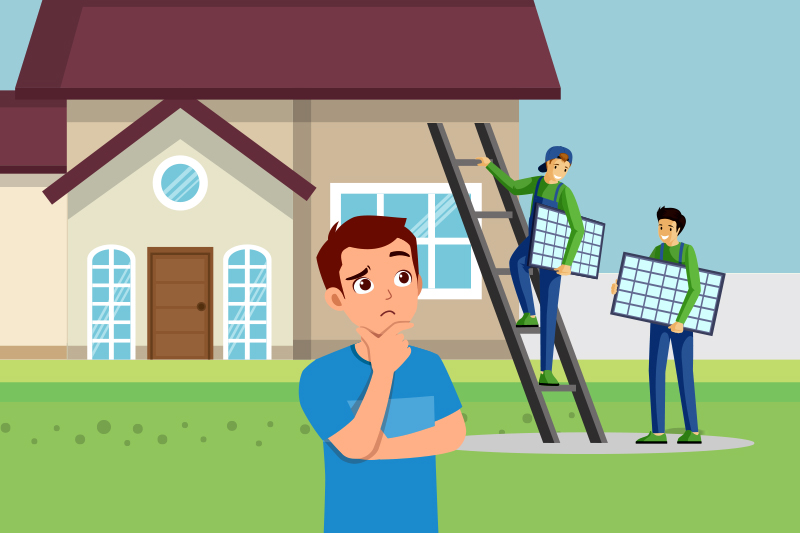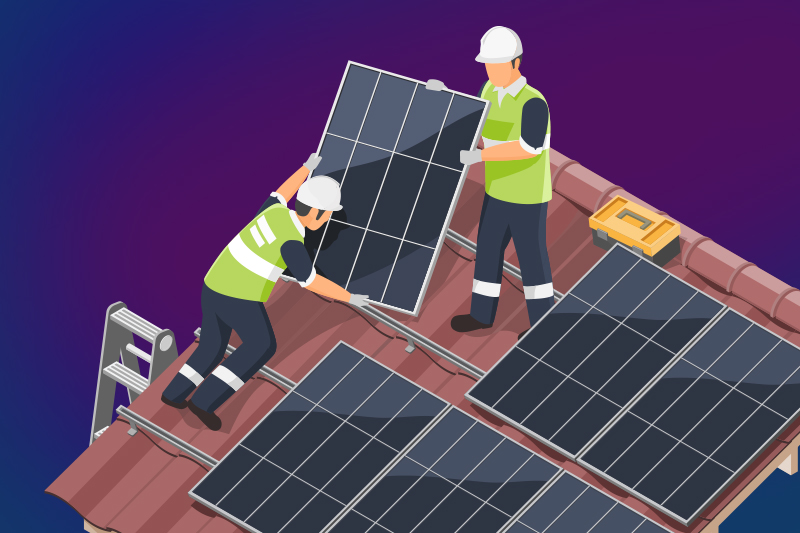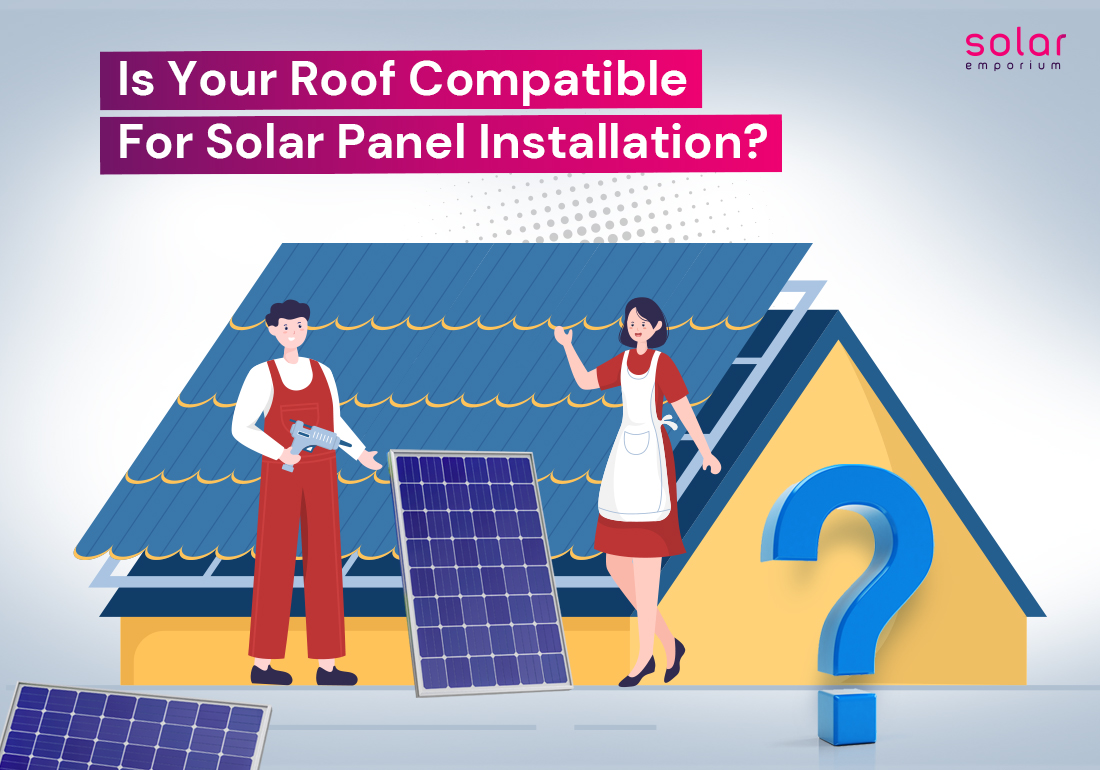Most new houses in Australia have concrete tiles or metal sheeting for their roofs, ideal for solar installations. However, many average Australian households have different materials.
Even some new homes are choosing these alternative materials. And today, we will try to answer a necessary question about solar panel systems.
So, is your roof compatible for solar panel installation? And whether these different roofing materials are compatible with solar energy systems.
Many roofs in Australia can have solar panels. Roof strength, shading, roof surface, direction, and slope can affect how well the solar panels work.
If a roof is strong enough for someone to walk on, it’s probably strong enough for solar panels. And roofs facing east or west make more electricity.
The angle of the roof should match where you live for the best electricity all year. Flat roofs are suitable. But you must be careful when installing solar panels to avoid shadows from other rows.
Generally, most Australian roofs should work well with solar panels and benefit homes or businesses.
Ideal Roofing Materials for Solar Installation
Choosing the best roof material is essential when installing solar panels.
Solar companies think about how easy it is to install, and they also care about the safety of your home and the installer. Hence, look at the best materials compatible with your solar roof.
Asphalt Shingles
These are becoming more popular in Australia because they are affordable and flexible. Fibreglass shingles, which are resistant to fire, are a good choice for Aussies.
Although asphalt shingles are cheaper than concrete tiles, they only last for a while because they deteriorate quickly. They are great for installing solar panels because they easily put railings and racks on.
If some shingles are damaged, they can be replaced easily. Since they are lightweight, adding solar panels usually doesn’t require changing the roof’s structure.
Metal Sheeting
Metal roofs are standard in Australia. They are made from materials like steel, tin, or aluminium. These are excellent for Aussie homes for their rust prevention, lightweight, fire resistance, and durability.
Metal roofs also spread heat well with solar panels. They act as an insulator in summer, lowering the house’s temperature.
Concrete Tiles
Concrete tiles are famous for Australian homes because they are affordable, durable, and insulated.
However, they add a significant weight to a house. It adds about 12 tonnes for an average-sized roof.
In comparison, metal roofs add approximately 1 tonne. This means a concrete tile roof may need extra support if you want to add solar panels.
Spare tiles should be available during installation, as installers may break some while walking on the roof.
Roofing Materials That May Cause Issues

Clay Tiles
Terracotta and other clay tiles are visually appealing but create challenges during installation. Unlike concrete tiles, clay tiles can break and have a lower load-bearing capacity.
Walking on the roof is likely to cause tile breakage. So, having plenty of spare tiles for the installer is essential.
Additionally, removing the tiles may compromise the roof’s water seal. Some installers choose to replace the tiles beneath the solar panels with more resilient composition tiles or use special solar panel mounting tiles.
Regardless, it will indeed become more expensive for a solar roof.
Slate Tiles
Slate roofs can be tricky for solar installation because of their fragile slate. Walking on the tiles will likely result in breakage.
Slate is the heaviest roofing material, requiring a structural assessment before adding solar panels.
Asbestos Roofs
Homes with asbestos roofs cannot have solar installations, as the Clean Energy Council prohibits.
The carcinogenic properties of asbestos pose a significant safety hazard for installers, along with its low load-bearing capacity.
If your roof is made of asbestos sheeting, it is strongly recommended to replace it for safety reasons.
Are Solar Tiles a Good Option?
You can change your roof or part of it into solar tiles. Solar tiles are like regular roofing tiles but also work as solar panels.
GoodWe have a new type called BIPV solar tiles that look good and work well. They are a great alternative to both regular roofing materials and solar panels.
Tesla also has a solar roof that can replace your whole roof and looks like a normal one. It’s even three times stronger than concrete tiles.
Roof Compatibility With Solar Energy
Not all roofs are the same. Older houses might need extra work or a complete replacement before adding solar.
Solar panels add about 350 kg of weight to your roof. Even though it spreads over a big area, your roof’s strength is still necessary. Solar installation often requires the panels to be attached to the joints in your roof.
If the joints are bad or the roofing materials are falling apart, you might have to fix those issues before adding solar.
Getting solar is more than just a significant investment for your home. It also adds value to your house.
On average, solar can increase your home’s value by $29,000. With the money you save from using solar, upgrading your roof is a good idea.
How is Your Roof Suitable For Solar Panels?

If your Australian roof is sturdy enough to handle someone walking on it, it’s likely strong enough for solar panels.
The effectiveness of solar panels depends on factors like roof strength, shade, angle, direction, and slope.
Shaded roofs make solar panels produce less electricity, but roofs facing east or west generate more solar energy.
Your roof’s angle should match where you live for the best electricity all year. If your roof is flat, it’s easy to work on.
But you should be careful during installation to prevent shades. It can make the panels work less. Most roofs should work well with solar panels and benefit your home or business.
What are the Best Roof Conditions for Solar Installation?
In Australia, most roofs can handle solar panels, bringing benefits to homes or businesses, although the results may vary.
The strength of your roof is crucial, and if it can support a person, it can likely hold solar panels.
Standard-pitched or skillion-style roofs with wooden trusses or rafters are suitable for solar panel systems.
Less shade on your roof throughout the year is ideal for the best solar production.
If your roof has heavy shading, getting a good result may be challenging, but installers can use tools like microinverters and optimisers to minimise power loss.
Roof surface matters too; while concrete tiles are easy to work with, terracotta and slate require extra care during installation.
Roof orientation affects power production, with northern-facing roofs being optimal, but easterly or westerly roofs can also be beneficial based on the time of day.
The roof slope influences performance, with the ideal angle matching the home’s latitude, but variations have a minimal impact on electricity generation.
Understanding these factors helps determine if your roof is suitable for solar and can maximise its benefits.
Space Requirements for Your Solar Roof

You might also wonder if your roof has enough space for solar. A standard 6.6kW solar panel system with 24 panels requires about 45 square meters of roof space.
But don’t worry if space is a concern. New technologies focus on high-wattage panels, requiring fewer panels for more power.
While a north-facing roof is typically best for solar, the northeast and northwest are also good. Installing panels on two sides of the roof is recommended to get the most energy throughout the day.
Contact Solar Emporium for the best solar solutions, and check out our solar packages.
Solar Roof Compatibility FAQs
What Exactly are Rooftop Solar Panel Systems?
Roof-mounted solar panel systems are typically available in flexible and rigid configurations. Bolts, brackets, and mounting hardware secure both to the roof of your RV or van.
The most durable option is rigid panels. Flexible panels have a low-profile appearance, are lightweight, and are easy to handle.
When Should I Change My Roof?
Before adding solar, checking if your roof is in good shape and not too old is essential. If your roof is close to the end of its life, replacing it before installing solar is wise.
Solar panels usually last 30 to 35 years, so if your roof is about five to 10 years away from needing replacement, it’s a good idea to have a professional assess its condition.
Replacing the roof before installing solar ensures you won’t have to remove everything a few years into your solar setup.
What's the Lifespan of My Roof?
Will Solar Panels Harm My Roof?
Properly mounted solar panels won’t damage your roof. The key is to use the proper mounting hardware for a safe and secure attachment to your rooftop.
If done correctly, solar panel installation should be suitable for your roof. Technology has improved, making mounting solar panels easier, and in some cases, solar panels can even protect your roof instead of causing damage.
Is Shading Bad for Solar Panels?
Solar panels can still work in the shade, but their capacity is reduced. A general rule is that panels in the shade produce about half as much energy as those in direct sunlight.
Trees to the north of your home pose the least shading obstruction. Trees on the north side can block the midday sun, crucial for solar power production.
Your roof’s features, like dormers and chimneys, can create shading challenges. While shade decreases efficiency, it doesn’t mean solar is impossible.
Which Way Should My Solar Panels Face?
In the Southern Hemisphere, solar panels work best on a north-facing roof. West-facing panels produce less energy in the morning but more in the afternoon, while east-facing panels do the opposite.
Panels facing south receive almost no direct sunlight. Panels should face true north for optimal efficiency, which may differ from magnetic north. If you can’t face them north, northeast and northwest-facing panels will also work, albeit with lower efficiency.







